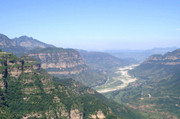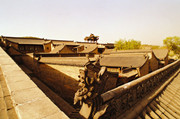Northern China's First Ancient Castle
Updated: 2012-03-01
 Crystal of ancient military culture
Crystal of ancient military culture
According to Zhong, the soldiers' hideout cell design was the most ingenious -- unlike the tunnels from previous dynasties. The cells were dug inside the city wall and each could hold about 40 soldiers. Soldiers hid in the cells and could quickly emerge to the surface when the enemy struck. Due to the strictly defended city wall and gate, the roving bandits tried in vain to take the ancient castles again and again.
Today, black-brick ancient castles are still in amazingly good condition after some 400 years. According to local experts, they were lined with bricks inside and out with rammed earth in between to make them into more solid defense systems.
Zhong, who has studied Chinese military architecture for many years, regards the defensive facilities as a milestone in Chinese ancient military culture:
"The defense of the cities in Chinese history mainly depended on the high and solid city walls and other accessorial facilities, such as entrenchments in front of the city wall, soldiers' hideout cells on the inside, tunnels and various emplacements on the top of city wall. Ancient castles mainly withstood attacks of non-fire weapons. With the advent of firearms era, city walls became very vulnerable in the face of powerful shellfire, and ancient castles gradually declined. However, these ingenious castles are still the crystals of ancient military culture."
 Masterpieces of Chinese architectural aesthetics
Masterpieces of Chinese architectural aesthetics
The ancient castles are not only original defense structures, but also masterpieces of Chinese architectural aesthetics. They are noteworthy for their harmony with nature, reaching the pinnacle of architecture and art in China.
Based on the traditional architectural aesthetic principle, the buildings inside the castles are all interconnected courtyards laid out like a chessboard. The buildings have more or less absorbed the architectural styles of the south of theYangtze Riversince their masters were usually merchants or officials who once engaged in business there.




